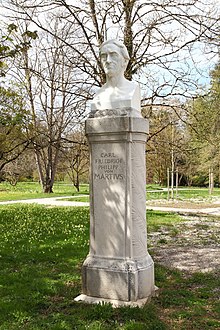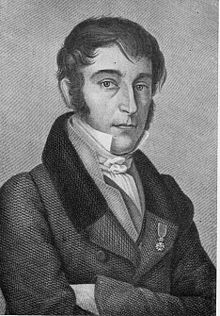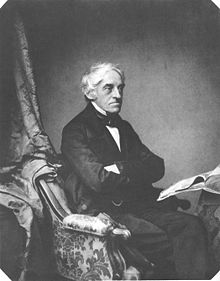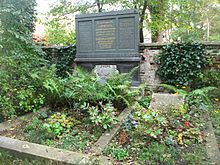Carl Friedrich Philipp von Martius
Carl Friedrich Philipp von Martius (born April 17, 1794 in Erlangen , † December 13, 1868 in Munich ) was a German naturalist , botanist and ethnographer . Its official botanical author abbreviation is " Mart. "
Live and act
Carl Friedrich Philipp von Martius was the son of the Erlangen court pharmacist Ernst Wilhelm Martius (1756–1849), who had been the first lecturer in pharmacy at Erlangen University since 1818. In 1810 Carl Friedrich Philipp von Martius began studying medicine in Erlangen. During his time in Erlangen he got to know Franz von Paula Cabinet and Johann Baptist von Spix . Inspired by this acquaintance and following his hobby, botany, he applied in 1813 to join the Eleven Institute, which was then part of the Bavarian Academy of Sciences . After passing the entrance exam, he was accepted into the institute on May 13, 1814 and placed under the control of the botanist Franz von Paula Cabinet as an assistant in the management of the newly founded botanical garden . In the same year he received his doctorate in medicine and surgery. In 1817, only 23 years old, he published his first major scientific work, the "Flora cryptogamica Erlangensis", a description of the flora in and around Erlangen. In 1816 he was elected a member of the Leopoldina .
The Brazil trip
From 1817 to 1820 Carl Friedrich Philipp von Martius undertook a research trip to Brazil on behalf of King Maximilian I of Bavaria together with Johann Baptist von Spix . The opportunity arose when Maria Leopoldine of Austria married the Crown Prince and later Emperor of Brazil, Dom Pedro , and the Bavarian King recommended two naturalists to the Austrian Archduchess as members of the Austrian Expedition to Brazil .
During the trip to Brazil he explored the Amazon and undertook extensive research on the tropical flora. He paid particular attention to the palm trees , which led to Martius becoming known as the "father of the palm trees". He also dealt with tropical medicinal plants. Spix and Martius brought a total of 85 species of mammals, 350 birds, 130 amphibians (according to today's understanding amphibians and reptiles), 116 fish, 2700 insects and 6500 plants and seeds from their travels to Munich . For scientists and biologists, many of the preserved animals and plants brought with them offer important information, as some of these species no longer exist or will no longer exist. Martius and Spix also discovered the fossils of the Santana Formation on their journey .
In addition, Martius intensively researched the life, culture and languages of the Brazilian Indians , especially the Tupí . His ethnographic descriptions are viewed critically nowadays because he made use of a racist physiognomic , for which the writings of Christoph Meiners served as a model. This is how Martius wrote about the indigenous Carirís and Sabujás:
"They are indolent, lazy and dreamy, dull to the impulse of other than the lowest passions, and even in their petty facial features they represent this state of moral stuntedness."
On the other hand, in a novel that was found in manuscript in 1831 and published in 1992, Martius not only assessed the country and people of the Amazon basin negatively, but also came to a positive overall assessment, which he put into the mouth of his protagonist (p. 146):
“What I have gained above all is respect for a human race that otherwise seemed like a rejected bunch of unfortunate people. Yes, man is not just the same in mind and spirit everywhere; everywhere he is also organized for his happiness. [...] In the act, a high profit, a true blessing is my higher respect, therefore my warmer love for all people, however colored their skin may be! [...]. "
Martius brought two children from Brazil to Munich from the indigenous peoples of the Juri and Miranha . These were baptized John and Isabella. Martius had bought them as a slave, but later recognized this as a serious mistake. Since they came from different ethnicities, they could not communicate with each other. They soon died despite good medical care. ( See also the grave relief of the Indian children Juri and Miranha . )
Martius was nearly shipwrecked on the Amazon in 1819. In gratitude for his salvation, he donated a cross for the Nossa Senhora da Conceiçao church in Santarém , which was made in Germany and shipped to Brazil after his return.
Further scientific career

In 1820, in recognition of his achievements on the trip to Brazil, Martius was elevated to the Bavarian personal nobility as a Knight of the Order of Merit of the Bavarian Crown and made a full member of the Bavarian Academy of Sciences. In 1826 he received a professorship at the University of Munich . In 1832 he became director of the Munich Botanical Garden. In the same year he became a member of the Prussian Academy of Sciences . In 1840 the Portuguese Queen Maria II awarded him the Knight's Cross of the Order of Our Lady . In 1845 he was elected to the American Academy of Arts and Sciences and in 1855 to the Royal Society of Edinburgh . In 1853 he received the Bavarian Maximilian Order for Science and Art .
Martius was a well-known member of Munich society, and many scientists were guests in his home. In particular, a Linnaeus festival (May 23) was held every year with songs, poems and speeches. After King Maximilian II had the Botanical Garden significantly reduced in size for the First General German Industrial Exhibition in 1854 in order to build the Glass Palace , Martius resigned prematurely from the position of Director of the Botanical Garden.
Martius married Franziska von Stengel in 1823 , a daughter of the ministerial official Georg von Stengel . His son was the chemist and Agfa founder Carl Alexander von Martius (1838–1920).
After Martius' death, most of his private plant collection was sold to Brussels. However, the important collections from Brazil are still a valuable holdings in the State Botanical Collection .
tomb
The tomb of Carl Martius is located on the old southern cemetery in Munich (Wall Links Course at 312 burial ground 15) location . The anatomist and physiologist Michael Pius Erdl also lies in this grave .
Posthumous honors
Martius in honor of the plant species were Martiodendron Gleason from the plant family of legumes (Fabaceae), Martianthus Harley & JFBPastore from the family of mint (Lamiaceae) and Martiusella Pierre from the family of sapotaceae named (Sapotaceae).
Von-Martius-Strasse in Bad Reichenhall bears his name, as does Martiusstrasse in Munich-Schwabing.
Martius - with Hans Staden - is the namesake of the Martius-Staden Institute in São Paulo, which is dedicated to researching the history of German immigration to Brazil and German-Brazilian cultural exchange.
Works
- Flora cryptogamica erlangensis . 1817.
-
Nova genera et species plantarum quas in itinere annis MDCCCXVII – MDCCCXX per Brasiliam jussu et auspiciis Maximiliani Josephi I Bavariae regis augustissimi instituto collegit et descripsit. Munich 1823-1832.
- Nova Genera et Species Plantarum Brasiliensium . ( Digitized panels (plantillustrations.org) - 1823–1832). - ( gallica.bnf.fr ).
- Icones plantarum cryptogamicarum, quas in itinere annis 1817 ad 1820 by Brasiliam… instituto collegit et descripsit . ( mertzdigital.nybg.org - 1828-1834).
- Journey in Brazil in the years 1817–1820 / Joh. Bapt. from Spix; Carl Friedr. Phil. Von Martius (Munich 1823–1831) ( biodiversitylibrary.org ).
- together with Hugo von Mohl and FJAN Unger : Historia Naturalis Palmarum . (Digitized tables: plantillustrations.org - 1823 to 1853). - ( gallica.bnf.fr ).
- New edition 1856–57 under the title Genera et species Palmarum. ( botanicus.org ).
- The Book of Palms - The Book of Palms . Reprint of the panels, with an introductory text by H. Walter Lack (ed.) In German, English and French, Taschen Verlag, Cologne 2010, ISBN 978-3-8365-1779-9 .
- Palmarum familia ejusque genera denuo illustrata . 1824.
- together with Franz von Paula cabinet : Hortus regius monacensis . 1829.
- Flora Brasiliensis . ( cria.org.br digitized tables: plantillustrations.org ). Martius was the founder and first editor of the series, which appeared from 1840 to 1906 (with a supplement in 1915). He also made many contributions to this himself. The Flora Brasiliensis served Benjamin Daydon Jackson as a basic work for the creation of the Index Kewensis .
- Description of some new nopaleas. In: Nova Acta Physico-Medica Academiae Caesareae Leopoldino-Carolinae Naturae Curiosorum Exhibentia Ephemerides sive Observationes Historias et Experimenta… Volume 16, Number 1, 1832, pp. 322-362 ( archive.org ).
- The potato epidemic of recent years or the rot and mange of potatoes. Munich 1842 urn : nbn: de: gbv: 9-g-3371758 .
- Systema materiae medicae vegetabilis Brasiliensis , Lipsiae - Vindobonae 1843. Digitized edition
- Contribution to the natural and literary history of the agavea. Reprint from Scholarly Ads ; 1855 No. 44–51 urn : nbn: de: bvb: 355-ubr00887-3 .
- Contributions to the ethnography and linguistics of America and Brazil. Reprint of the 1867 edition from 1969
- Frey Apollonio. Roman from Brazil, experienced and told by Hartoman. based on the handwritten original from 1831, Dietrich Reimer Verlag, Berlin 1992, ISBN 3-496-00418-5 .
- Goethe and Martius. Nemayer, Mittenwald 1932, urn : nbn: de: hbz: 061: 2-169559 .
Sources and further information
swell
- Robert Zander : Zander concise dictionary of plant names. Edited by Fritz Encke , Günther Buchheim, Siegmund Seybold . 13th, revised and expanded edition. Eugen Ulmer, Stuttgart 1984, ISBN 3-8001-5042-5 .
- Andreas Bresinsky: Carl Friedrich Philipp von Martius and his novel “Frey Apollonio” with a view of the Amazon basin of Brazil two centuries ago In: Hoppea, Denkschr. Rain. Bot. Ges. 78 (2017): 7-21.
- Harald Förther: The history of Martius herbarium: his Brasilienkollection and recommendations for Type Selection In: Sendtnera 2, 1994, p 5 -24.
- Harald Förther: Carl Friedrich Philipp von Martius - an early cactus researcher! In: KuaS 46, No. 9, 1995, pp. 205-210.
- The Martius Project . (Portal with selected documents from Martius' herbarium collection)
literature
- Ernst Wunschmann: Martius, Carl Ritter von . In: Allgemeine Deutsche Biographie (ADB). Volume 20, Duncker & Humblot, Leipzig 1884, pp. 517-527.
- Elke Bujok and Jörg Helbig: The “Brazilian-Bavarian Expedition” by Spix and Martius 1817–1820. In: Munich contributions to ethnology. Volume 15, 2012/2013, pp. 42-71.
- Jörg Helbig (Ed.): Brasilianische Reise 1817–1820: Carl Friedrich Philipp von Martius for his 200th birthday. Hirmer, Munich 1994 ISBN 3-7774-6550-X .
- Karl Mägdefrau: Martius, Carl Ritter von. In: New German Biography (NDB). Volume 16, Duncker & Humblot, Berlin 1990, ISBN 3-428-00197-4 , pp. 310-312 ( digitized version ).
- Karl Heinrich Oberacker: The German contribution to building the Brazilian nation. Herder, São Paulo 1955. In it pp. 206–209: Karl Friedrich Philipp von Martius and Johann Baptist von Spix.
- Sylk Schneider: Brazilian travel and botany with Carl Friedrich Philipp von Martius. In: Sylk Schneider: Goethe's trip to Brazil. Weimar 2008, ISBN 978-3-937939-69-8 , pp. 114-130.
- Bernd Schmelz: Carl Friedrich Philipp von Martius. Father of Brazilian Ethnology: A Biographical Introduction. Museum für Völkerkunde Hamburg Working Papers No. 2.
- Tilman Spreckelsen: The all-rounder from paradise. In: Frankfurter Allgemeine Sonntagszeitung . October 17, 2010, pp. 64, 67.
Individual evidence
- ^ Karl Mägdefrau : Martius, Carl Ritter von. In: New German Biography. 16, 1990, pp. 310-312.
- ↑ JB Spix and CFPH. Martius: Travel to Brazil on the orders of Sr. Majesty ... Band 3 , 1831, p. 1387 .
- ↑ Frederik Schulze: Concepts of physiognomy and race in Martius. In: Revista Contingentia 3.2008,2, pp. 117-132.
- ^ Andreas Bresinsky: Carl Friedrich Philipp von Martius and his novel "Frey Apollonio" with a view of the Amazon basin of Brazil two centuries ago In: Hoppea, Denkschr. Rain. Bot. Ges. 78 (2017): 7-21.
- ^ Schönitzer, Klaus: From the new to the old world. Two indigenous children brought back to Germany by Johann Baptist Spix and Carl Friedrich Martius . In: Journal of Five Continents . tape 1 , 2015, p. 78-105 ( schoenitzer.de [PDF]).
- ↑ Fonseca, W. Dias da: The Cross of Santarem . In: Staden yearbook . tape 42 , 1994, pp. 113-117 .
- ^ Government Gazette for the Kingdom of Bavaria , No. 49, Munich, December 7, 1840
- ↑ Hans Körner: The Bavarian Maximilian Order for Science and Art and its members. In: Journal for Bavarian State History. Volume 47, 1984, pp. 299-398. ( periodika.digitale-sammlungen.de ).
- ^ S. von Moisy: Martius in Munich. Highlights from domestic and social life . In: J. Helbig (Ed.): Brasilianische Reise 1817 - 1820 . Hirmer Verl., Munich 1994, p. 85-116 .
- ↑ H. Fört: The history of the martius herbarium: its Brazil collection and recommendations for the choice of type . In: Sendtneria . tape 2 , 1994, p. 5-24 .
- ↑ The common grave of Martius and Erdl ( Memento of the original from February 7, 2017 in the Internet Archive ) Info: The archive link was inserted automatically and has not yet been checked. Please check the original and archive link according to the instructions and then remove this notice.
- ^ O Instituto Martius-Staden de Ciências, Letras e Intercâmbio Cultural Brasileiro-Alemão , accessed on February 27, 2014.
- ^ Benjamin Dayton Jackson: The new 'Index of Plant-Names'. In: The Botanical Journal - British and Foreign. Volume XXV. West, Newman & Co., London 1887, pp. 66-71.
- ↑ Lotte Burkhardt: Directory of eponymous plant names - Extended Edition. Part I and II. Botanic Garden and Botanical Museum Berlin , Freie Universität Berlin , Berlin 2018, ISBN 978-3-946292-26-5 doi: 10.3372 / epolist2018 .
Web links
- Literature by and about Carl Friedrich Philipp von Martius in the catalog of the German National Library
- Author entry and list of the plant names described for Carl Friedrich Philipp von Martius at the IPNI
| personal data | |
|---|---|
| SURNAME | Martius, Carl Friedrich Philipp von |
| BRIEF DESCRIPTION | German naturalist, botanist and ethnographer |
| DATE OF BIRTH | April 17, 1794 |
| PLACE OF BIRTH | gain |
| DATE OF DEATH | December 13, 1868 |
| Place of death | Munich |




